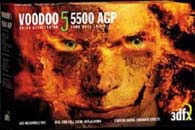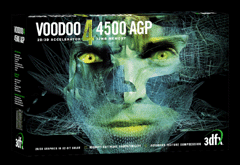HWSW interview with Alf Covey of 3dfx
A PC-s játékosok körében a 3dfx név hajdan a 3D grafika szinonimája volt. Ám a Voodoo(1) 3D-gyorsítókártyák megjelenése óta számtalan versenytárs jelent meg a piacon; s ennek eredményeképpen az a cég, amely néhány évvel ezelőtt a háromdimenziós játékok által nyújtott - akkoriban utolérhetetlennek gondolt - egyedi látványvilágot PC-ink monitorára varázsolta, ma komoly kihívókkal kell, hogy szembenézzen. És bizony jelen pillanatban nincs jó bőrben. Ezért is éreztük elérkezettnek az időt arra, hogy néhány keresetlen kérdést intézzünk Alf Covey-hoz, a 3dfx PR menedzseréhez a cég nehézségeivel, jelenével és jövőjével kapcsolatban.
HWSW: In terms of financial results, 3dfx had to suffer a very bad first quarter. Can we expect some changes in development and marketing strategy that might help retrieve the company's honor? Also rumor has it that you plan to sell the card manufacturing capacity you obtained with the acquisition of STB. Is this true?
Alf: Changes are on the way and this is something we have been trying to make as public as possible. We have very good technology in the pipeline and are executing on it, which is a very important factor in turning things around. Additionally, the various problems encountered this past quarter, which affected profitability, have been dealt with and put behind us.
We are certainly going to continue making cards. While we are always trying to streamline costs and explore other methods of development, we are still planning on manufacturing our own cards.
HWSW: If 3dfx endeavored to keep pace with the controversial six-month product cycle that NVIDIA dictates and meets from time to time, the V5 6000 card - targeted at the community of hardcore gamers - ought to be on retailers' shelves already. Do you have some reservations about this aggressively - or as I prefer to put it, cruelly - rapid product cycle? And what are the reasons for the delay?
Alf: We plan on delivering cutting edge technology and if that requires a six-month product cycle, we intend to be there. Getting back on track was our number one goal. Execution with all products is essential when you have such an aggressive product cycle and roadmap. Getting our mainstream products (Voodoo4 4500 and Voodoo5 5500) were our goals once we got Napalm back on track. Now that we have given the Voodoo4/5 "mainstream" products an introduction to the retail shelves, our focus shifts to the high-end, Voodoo5 6000. We feel that delivering a quality product in the end is the most important factor to a consumer. As for why it was later than say the Voodoo5 5500, as I have been quoted as saying before, that is simply because it is not the 5500. Any new product has its own issues that must be dealt with.
[oldal:Q&A 3-5]
HWSW: Analysts claim that the PC version of your V4 4500 came a bit late in the day. Though it may be marketable to OEMs and SIs, your one-time most committed stratum of consumers, i.e. gamers do not seem to be overjoyed at the performance of this product. What particular segment is this card targeted at?Alf: I have to disagree with that assessment. The top selling board in retail continues to be the Voodoo3 series. Certainly by todays standards, it would not be considered "high-end" yet continues to have very strong sales. We've said from the first announcement that the cards for the gaming enthusiasts will be the Voodoo5 series. We've also said from the start that the Voodoo4 is for the entry-level market, which would include OEM systems and business-oriented platforms. Clearly not all gamers have $300 or more to spend on graphics cards, nor do all of them insist on playing Quake3 at 100FPS, and those consumers should not be penalized.
It doesn't really make any sense for any one to try and compare an entry-level accelerator with performance monsters. The 4500 provides fantastic 2D (on the Mac, its unparalleled), 3D and 3dfx's RGSS full scene anti-aliasing to an entry-level market for consumers and platforms that might otherwise not be able to experience these features. Looking at what the Voodoo4 4500 offers to the market for $149, we expect it to continue the excellent sales that we achieved with the Voodoo3 series.
HWSW: Are you working on Linux drivers for the V4/5 series?
Alf: Absolutely! We have open-sourced our Linux code for the community. We plan to continue driver development for Linux and other open-source codes like BeOS.
HWSW: As NVIDIA has just won over Epic Games for their cause, one of the last bulwarks of 3dfx's excellent API (Glide) seems to be threatened by a lethal siege. The Unreal-engine of the future will be optimized for NVIDIA GPUs. Many analysts suggest that we should begin digging the grave of Glide. However, I guess you are not planning on distributing spades. Am I wrong?
Alf: You are not wrong at all! Glide is still a very strong API. Just because one future game engine at this stage in the game says it will not support Glide does not mean no other games will be released with Glide support. It certainly does not invalidate any of the many, many Glide titles that are on sale and in use today. As for "winning over" Epic games, I think that's a bit of a misnomer and one that should be addressed due to its popularity. NVIDIA is in a position that is not uncommon and certainly not exclusive... it is standard for technology to be submitted to developers during the design phase. By no means does it mean that the game will only work with an NVIDIA card. All that this means is that instead of developing for Glide and D3D or OpenGL, they will instead spend more time focusing on D3D or OpenGL instead of Glide. We open-sourced Glide last year and have announced that we would be focusing the vast majority of our time on D3D and OpenGL; just like Epic games.
[oldal:Q&A 6-9]
HWSW: As far as I am informed, since the appearance of the V5 series no games supporting T-Buffer Cinematic Effects has seen the light of day. Is everything going well at the Developer Relations department? That is, can we expect some changes in the future in this respect.Alf: Things are going well with developer relations. With any new technology like T-Buffer, there is going to be some lag time in incorporating it into software. Preliminary feedback we've received from demos made available to the public are very positive. Microsoft has made it clear that they want many features that are part of our T-Buffer effects like FSAA, Motion Blur and Depth of Field in DX8. Clearly, this is a market direction that we helped start.
Also, when you mention, T-Buffer it seems people forget that FSAA was a feature of T-Buffer. While we did not pioneer the first ever use of FSAA, we made FSAA a useable feature in games and were responsible for the huge rush of FSAA reviews/previews and discussion on the web. Clearly, we made competitors follow our lead in FSAA because it was a feature that every game can use today.
HWSW: Your company's entering the Mac market smacks of being a success story. Can you subscribe to this view?
Alf: The Mac market has really taken hold of us with open arms. For a long time they have been neglected in the graphics market, as 3D cards were virtually non-existent. Last year we introduced non-supported V3 drivers for Macs and had Mac users buying up cards like crazy. Now that we have introduced our Voodoo4/5 products to the Mac market, we have fully integrated with Mac users. We are still working on becoming a BTO option and we feel that becoming a BTO is something Mac users really want. Not only does 3dfx offer the best 2D or the Mac market, but also the best 3D experience.
HWSW: Once you told me in a Q&A that hardware T&L and such special instruction sets as SSE or 3DNow! are exclusive solutions developed for the same purpose. As a response to your claim Chris Donahue of NVIDIA said: "The relationship [between these two solutions] is symbiotic if we optimize the data paths to get the data to the GPU faster then it stands to reason that the entire application will benefit. There is nothing exclusionary and these are complimentary." I would not be surprised if the average user became a bit baffled here. Would you help us clarify this issue?
Alf: Hmmm.. that did sound a bit confusing. Let me see if I can clarify...
Whether you use hardware T&L or software T&L (through SSE or 3Dnow! or even Microsoft's DX7) they essentially accomplish the same thing, but by different methods. Whether you make a call to the CPU or the hardware on the board does it, the net result should be faster performance for whatever game you are playing. Even though SSE are 3Dnow! are "instruction sets" written on the CPU, those commands are still performed by the CPU. Using DX7, accelerating geometry is done by D3D. As I said previously, you can use the graphics hardware or the CPU, but they are not complimentary. They do not scale together; they are exclusive and as such only one method or the other may be selected.
HWSW: Video chip makers are heavily working on solutions to overcome the memory-bottleneck issue. I have a fair guess that you are working on some technology too. Is the multiplication of chips your final word in this?
Alf: I'm not deeply enough into that process to comment on what the "final word" is (not that if I were, I'd risk the job by saying... hehe). However, I can say that a multiple chip solution certainly is "a word." It is an extremely innovative and effective way to increase bandwidth and alleviate limitations. AMD/Intel processors, Voodoo1, Voodoo2 and Voodoo 5 are all proof of that. The Voodoo5 has more realized potential bandwidth than competitive offerings because of this innovation.
[oldal:Q&A 10-10.33]
HWSW: Not long ago, John Carmack said the following to PlanetQuake: "64 bit pixels. It is The Right Thing to do. Hardware vendors: don't you be the company that is the last to make the transition." Do you plan on making this transition? Is 64 bit rendering the future?Alf: 3dfx is The Gamer's Card. If any specific "transition" is in the future, 3dfx will be there.



HWSW.33: And my obligatory 0.33 question: in my view, no other video card manufacturer can boast of such attractive boxes that your products are wrapped up in. Who can be made responsible for the invention of this fascinating design?
Alf: Our Marketing team does a great job with the boxes. Dave McKean is the name of the artist that came up with the design for the Voodoo4/5 boxes. He's a fairly well known artist who does a lot of surreal work like that. They are extremely slick and we appreciate hearing your comments!
Thank you very much, Alf!